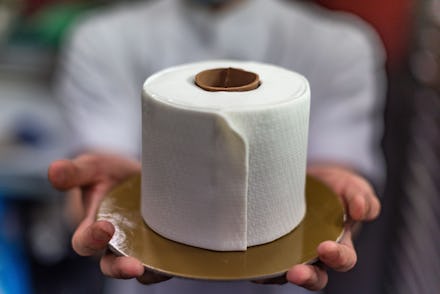The psychology behind why cakes in disguise are so disturbing

By now you may have seen a mega-viral video of a selection of seemingly-everyday objects like Crocs, house plants and toilet paper being sliced in half to reveal that they’re actually elaborately decorated cakes. The single video, shared by Tasty (but created by Turkish baker Tuba Geckil), has garnered over 30 million views on Twitter alone and rising.
The clip has proved to be a catalyst for an explosion of cake related memes, pointing out the skillful absurdity of realistic fondant cake sculptures. One comic in particular, by Portuguese cartoonist Raphael Salimena has itself become a widely shared meme that seems to capture the awe — and the discomfort of these cakes. In short, some people are delighted by these creations. But, like me, some people find them horrifying.
Seeing a butcher knife carve into items I thought were solid only to find out that they're a sugary, fluffy, fondant-coated cake makes me very uncomfortable. I honestly can't watch a whole video without cringing. There are so many horrifying examples of cake trickery, like this unnerving video of a baby made of cake that you should only look at if you’re into slasher movies and American Horror Story. And yet, the sight of a silver teapot being aggressively sliced in half with a giant butcher knife also leaves me yearning for simpler days of cake pops and cupcake stands. I had to find out why seeing dessert illusions messes with my brain the way that it does.
“There are several possible mechanisms that could account for your discomfort,” says Pascal Wallisch, a clinical associate professor of psychology and data science at New York University. “One is the possibility that the human visual system contains detectors that monitor whether an important stimulus — like another human — is somehow ‘off’, for example, if what you’re looking at is impaired or diseased, which would be important information in guiding interactions.”
The discomfort Wallisch is describing is often referred to as “the uncanny valley.” The phenomenon, which was coined by roboticist Masahiro Mori in 1970, and is typically used to describe the uncomfortable feeling that you get when you look at something that looks human but actually isn’t. Think Westworld: when we see or interact with a human-like being, like popular Internet celebrity and artificial intelligence Sophia the Robot, we experience a peculiar dissonance when she and her extremely prescient jokes turn out to not be human at all.
"The uncanny valley is a major challenge for people trying to create human-like robots or computer generated animations,” Wallisch tells Mic. “Generally speaking, there is a lot of empirical support that liking of depictions of actual humans is high, and images of clearly non-humans — think R2D2 or C3PO — is high, but in between is the "uncanny valley" of low ratings for depictions that are close, but not quite right. This has been cited as the basic reason why some people think clowns are creepy or zombies are scary.”
“The uncanny valley effect isn’t very well understood. It usually refers to the emotional reaction when people encounter a non-human that resembles a human, like a realistic robot or cartoon. Some people enjoy it and others get upset, and it’s not always clear why,” says Aimee Daramus, a Chicago-based psychotherapist. “In a world where violations of our reality are the norm, a video of a red croc shoe that turns out to be cake and frosting. It’s surreal. It’s like the exact opposite of 2020, because reality is getting distorted in a good way for once.” That is, at least, until some skilled artisan decides they’re going to make a cake that looks just like their own hand and ceremoniously cuts it in half.
To bring it back to dessert dissonance, elaborately decorated cakes aren’t at all a new thing—fondant was invented all the way back in the 16th century and quickly became a status symbol. It wasn’t until the 20th century that rolled fondant became a cheaper, more accessible, and widely used item for decorating desserts. There’s also shows all over TV about cake decorating that use the clay-like but edible material to great enjoyment, like Nailed It, Cake Boss, and Crazy Delicious. But those cakes pride themselves more on artistry and less on trickery. As time marches on, there’s a one-upmanship of these craftspeoples’ skills and it leads to a stunning recreation of famous portraiture, only to have a creepy feeling set in when inevitably, the cakes are cut into.
“We’re generally not supposed to eat babies, dogs, or toilet paper,” adds Daramus. “Some of these cakes are breaking taboos in a big way. Eating things we connect with dirtiness — rats, toilet paper — or affection — babies and dogs, for example — are equally appalling in different ways.” Taboos, she says, are also connected on a primitive level with bringing bad luck or being cursed. So there’s a reason we cringe.
Even though a lot of these cake illusions activate a deep discomfort in our primitive brain, the cake memes and jokes continue to abound, and cake cutting videos both terrifying and pleasing will surely continue to populate YouTube and our social media feeds. “I’m not surprised that cake memes are trending in 2020, though,” Daramus reflects. “Our sense of reality has been so torn apart this year that these cakes are practically symbols of life right now.”